By Steve Chagollan
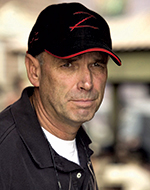 Martin Campbell, who directed Daniel Craig's first outing as James Bond with 2006's Casino Royale (he also directed Pierce Brosnan's maiden voyage as 007 in 1995's GoldenEye) knows a thing or two about orchestrating large-scale action sequences. But the relatively intimate three-part poker game in Casino Royale had him sweating the details. "A Bond movie traditionally has a lot of action in it," says the New Zealand-born director. "It moves at a fair pace. So I have to say that I was genuinely worried about dropping the film in its tracks with a card game."
Martin Campbell, who directed Daniel Craig's first outing as James Bond with 2006's Casino Royale (he also directed Pierce Brosnan's maiden voyage as 007 in 1995's GoldenEye) knows a thing or two about orchestrating large-scale action sequences. But the relatively intimate three-part poker game in Casino Royale had him sweating the details. "A Bond movie traditionally has a lot of action in it," says the New Zealand-born director. "It moves at a fair pace. So I have to say that I was genuinely worried about dropping the film in its tracks with a card game."
One thing he did as prep was watch what he called "all the best movies about card-playing": The Cincinnati Kid (1965, Norman Jewison), Maverick (1994, Richard Donner) and 5 Card Stud (1968, Henry Hathaway). He also changed the game from the baccarat of Ian Fleming's book to Texas Hold 'Em, a game much closer to straight poker and that a lot more people recognize. Nevertheless, "It's not about the game itself," explains Campbell, "it's the people playing the game that hold your attention."
In this case it's Bond and the film's arch villain, Le Chiffre (Mads Mikkelsen), who is gambling with $150 million of a terrorist organization's money, and therefore his life if he loses. The two engage each other throughout in what Campbell calls a "competitive, eyefucking stare." The following sequence comprises the game's final round, which has narrowed down to four players.

The salon's lavish interior had to complement the exterior, "a massive bath house in Karlovy Vary that had a rather elegant first-floor level." The Czech location actually doubled for a coastal city in the Baltic country of Montenegro, which is bordered on the West by the Adriatic Sea. Campbell had the salon built on a soundstage at Barrandov Studios in Prague, where incentives are favorable and the infrastructure for filming is world-class. Working with production designer Peter Lamont and a team of art directors, Campbell says the ambience was meant to evoke "wealth and sophistication."
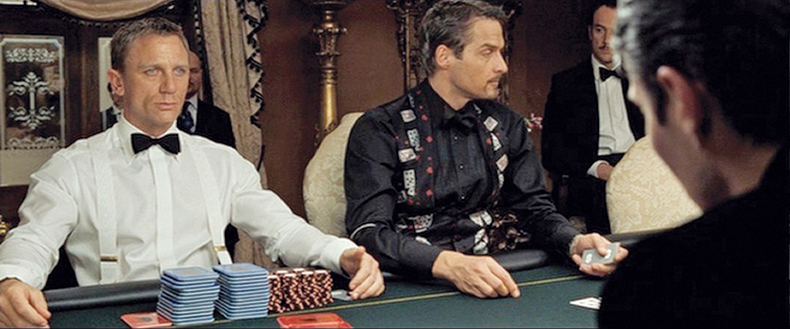
Bond has removed his jacket and looks like he's ready to get down to business—his arms spread as if he's embracing his chips, with a very intense stare directed at Le Chiffre. "It's extreme confidence," explains Campbell about Craig's body language. "In fact, over-confidence in a way, because his whole character in Casino is someone who is not yet the sophisticated Bond. But in this scene, it's really about that casual, totally-at-ease confidence, that he's totally in command. You never feel any sort of tension."
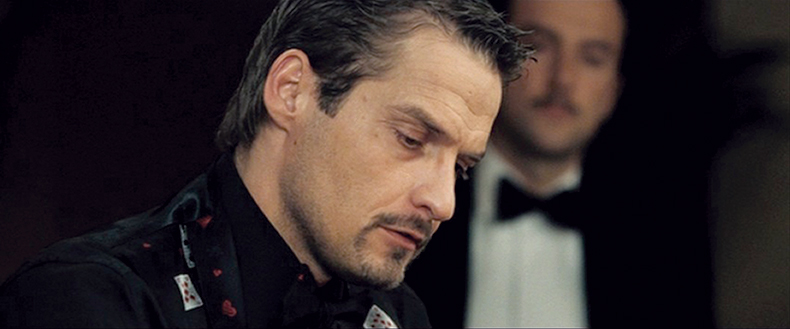
Campbell says he cast Andreas Daniel, an Austrian, as the dealer because "he really looked perfect." Daniel had the added advantage of being a dealer in real life. "These professional guys, of course, have to remain above the fray, basically," says Campbell, "very calm, very neutral. Then, of course, he can handle the cards very beautifully." Campbell also enlisted producer Michael Wilson, "who knew the game intimately, to teach the actors how to play, and even took Craig and Mikkelsen to the casinos at night. Michael rehearsed them in the technique and educated them for the whole sequence."
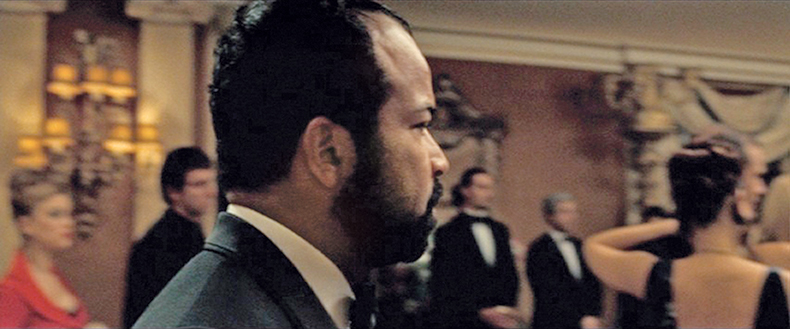
As the stakes continue to climb, Felix Leiter (Jeffrey Wright), a CIA agent and Bond ally, enters the room, with the camera gliding with him. "It's what I call a 'hunting camera,'" says Campbell. "There are always two angles, two cameras going on here. And if we get into trouble, I can always cut to the master."

"Whether you choose to shoot close-ups or whether you choose to shoot close over the shoulders," explains Campbell, "you use a long focal lens—a wide lens. The intercuts between Bond and Le Chiffre, and between the other players, is extended to a much greater degree than the earlier sequences. And that is because so much more is at stake, life or death is at stake. And these are big, long focuses over shoulders where the foreground person is blurred. It's meant so you focus on just the eyes of both players. Mads Mikkelson developed this ability to click the chips, turning them over with one hand, which I encouraged, this 'click, click, click'—almost a musical kind of beat, as it were, which just raises the tension."

After what seems like an eternity, but is actually barely a half minute, Bond throws everything he's got—$40.5 million—into the pot, dispensing with the niceties by shoving it forward into a messy pile. "He leans forward in a swagger," explains Campbell. "It's like throwing down the gauntlet. It's basically saying, 'I've won this.'"
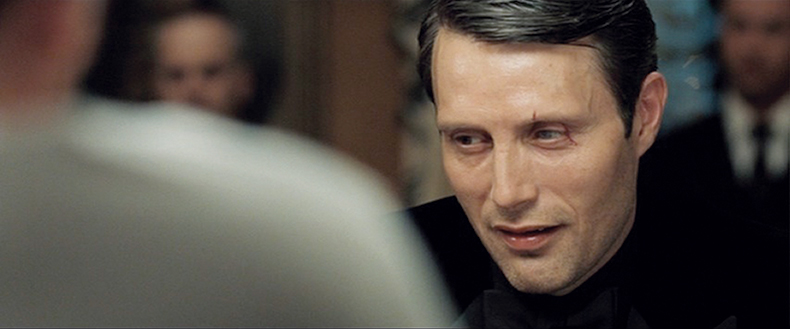
Le Chiffre changes expression to surprise, even mild shock. "I talked to the actors about what needed to be expressed internally versus externally," says Campbell: "What they are thinking, working out the mechanics and the odds of the game in their minds, showing only the slightest hint that they might be a little tense, a little worried when they don't necessarily believe they have a strong hand but hoping it's enough. Because the 'poker face,' by its very definition, is one of not giving anything away."

Le Chiffre, with a full house, aces over sixes, rebounds with a defiant smile, glancing over at his paramour with confidence. "In terms of reaction shots from people in the wings, we had all the actors there, so we pretty much stuck with continuity, which was unusual, but the game was too complex to shoot out of order. Every time we called cut, we had six props people restoring everything to what it was before."
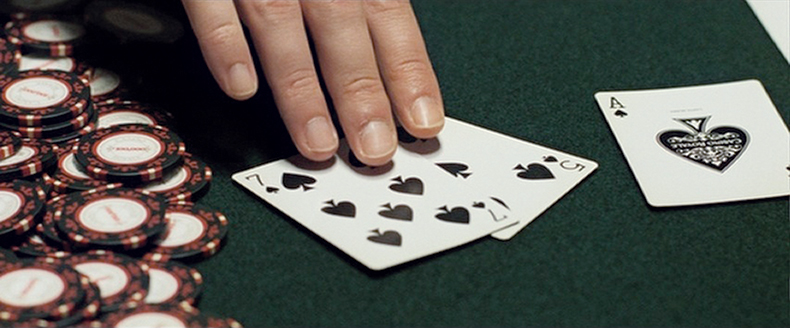
When Bond shows his hand—a straight flush—Le Chiffre's defiance turns immediately to shock and he will quickly exit the room.
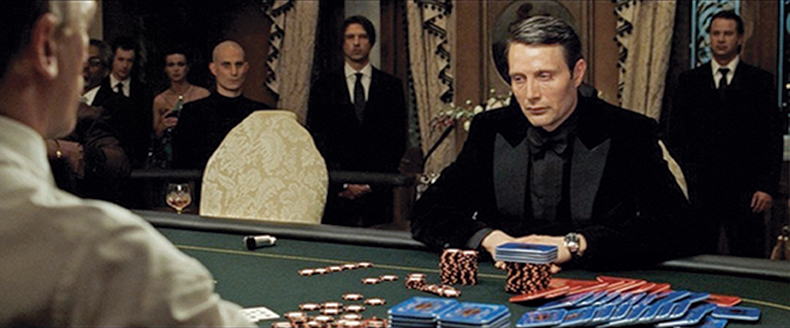
Again, says Campbell, "Most of the sequence was single-camera. The only time I used two cameras was for the wide master shots, shooting from one end of the table, and then a shot from the side of the table. I'm not one who uses many cameras at all, because it just compromises it too much. I tend to work out the angles very carefully. It took an awful lot of working out, I can tell you. It's sort of the classic film school thing of teaching people about eyelines. Put five people around an oval table and have more people talking to each other. Now you have to work out where the eyelines go—left to right? Right to left? Wherever."